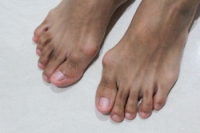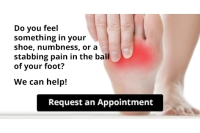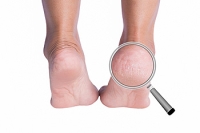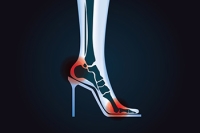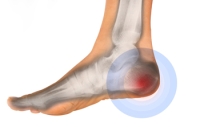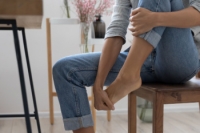
Blog (807)
Facts About Bunions
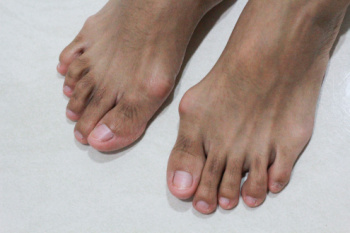
A bunion, or hallux valgus, is a bony bump that forms at the base of the big toe. A bunion develops gradually as the big toe shifts inward toward the smaller toes and places stress on the joint. Because this joint supports a significant amount of weight while walking or standing, people with bunions often experience pain, swelling, and redness in the affected area. In some cases, calluses may form where the toes rub together. Over time, bunions can worsen, making it uncomfortable to wear regular shoes or walk without discomfort. While they are most commonly seen in adults, some children are born with bunions or develop them in adolescence. Factors such as inherited foot structure, joint deformities, and certain inflammatory conditions may contribute to bunion formation. Wearing tight or narrow shoes may not directly cause bunions, but they can aggravate existing ones. A podiatrist can assess the severity of a bunion and recommend treatment, such as supportive footwear, orthotics, or surgery if needed. If you have a bunion that is causing pain, it is suggested that you schedule an appointment with a podiatrist for an exam and appropriate treatment.
If you are suffering from bunion pain, contact Dr. Kenneth Donovan of Advanced Care Foot and Ankle. Our doctor can provide the care you need to keep you pain-free and on your feet.
What Is a Bunion?
Bunions are painful bony bumps that usually develop on the inside of the foot at the joint of the big toe. As the deformity increases over time, it may become painful to walk and wear shoes. Women are more likely to exacerbate existing bunions since they often wear tight, narrow shoes that shift their toes together. Bunion pain can be relieved by wearing wider shoes with enough room for the toes.
Causes
- Genetics – some people inherit feet that are more prone to bunion development
- Inflammatory Conditions - rheumatoid arthritis and polio may cause bunion development
Symptoms
- Redness and inflammation
- Pain and tenderness
- Callus or corns on the bump
- Restricted motion in the big toe
In order to diagnose your bunion, your podiatrist may ask about your medical history, symptoms, and general health. Your doctor might also order an x-ray to take a closer look at your feet. Nonsurgical treatment options include orthotics, padding, icing, changes in footwear, and medication. If nonsurgical treatments don’t alleviate your bunion pain, surgery may be necessary.
If you have any questions, please feel free to contact one of our offices located in Warren, Livingston, and Toms River, NJ . We offer the newest diagnostic and treatment technologies for all your foot care needs.
Factors to Consider When Choosing Running Shoes
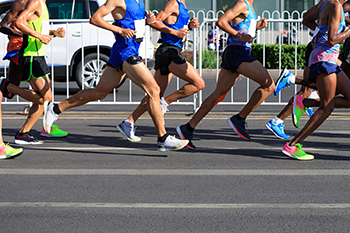
Choosing the right running shoes is important for foot health and injury prevention. Proper arch support helps distribute pressure evenly, reducing strain on the heels and forefoot. Cushioning is necessary to absorb impact, lessening stress on the joints and soft tissues. The fit of your running shoes should be secure, but not too tight to avoid blisters, black toenails, and nerve compression. Toe box width is another factor, as shoes that are too narrow can cause pain and deformities over time. The shoe’s flexibility should match natural foot movement to prevent unnecessary strain on the toes and ankles. Stability is essential, as inadequate support can increase the risk of sprains or tendon injuries. The type of running surface also matters, as road and trail shoes provide different levels of traction and shock absorption. A podiatrist can assess your foot structure and gait to recommend shoes that improve comfort and help prevent running-related injuries. If you have foot pain or other ailments caused by running, it is suggested that you schedule an appointment with a podiatrist for an exam, diagnosis, and treatment options.
If you are a runner, wearing the right running shoe is essential. For more information, contact Dr. Kenneth Donovan from Advanced Care Foot and Ankle. Our doctor can provide the care you need to keep you pain-free and on your feet.
Choosing the Right Running Shoe for Your Foot Type
To increase performance and avoid the risk of injury, it is important to choose the right running shoe based on your foot type. The general design of running shoes revolves around pronation, which is how the ankle rolls from outside to inside when the foot strikes the ground.
- Neutral runners are able to choose from a wide variety of shoes, including minimalist shoes or even going barefoot.
- Runners who overpronate, or experience an over-abundance of ankle rolling, should choose shoes that provide extra motion control and stability.
- Runners who underpronate, or supinate, have feet that have high arches and lack flexibility, preventing shock absorption. They require shoes with more flexibility and cushion.
If you have any questions please feel free to contact one of our offices located in Warren, Livingston, and Toms River, NJ . We offer the newest diagnostic and treatment technologies for all your foot and ankle needs.
Why Live with Pain and Numbness in Your Feet?
Understanding Skin Fissures on the Heels
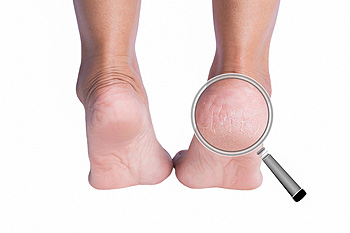
Skin fissures on the heels are caused by dry, cracked skin. These painful cracks can develop deep enough to bleed and are often accompanied by rough, flaky skin. Symptoms include a feeling of tightness, discomfort while walking, and visible cracks, especially in the winter months when the air is drier. The main causes of heel fissures are prolonged dryness, standing for long periods, wearing ill-fitting shoes, or not moisturizing enough. People with conditions like diabetes or obesity are also more prone to heel fissures due to added pressure on the feet. If you experience heel fissures, a podiatrist can help by assessing the severity of the cracks and offering treatment options. Included are prescription creams, padding to relieve pressure, or debridement, which is the removal of dead skin. This type of doctor may also provide advice on proper footwear and foot care routines to prevent further damage. If you have severely cracked heels, it is suggested that you schedule an appointment with a podiatrist.
If the skin on your feet starts to crack, you may want to see a podiatrist to find treatment. If you have any concerns, contact Dr. Kenneth Donovan from Advanced Care Foot and Ankle. Our doctor can provide the care you need to keep you pain-free and on your feet.
Cracked Heels
It is important to moisturize your cracked heels in order to prevent pain, bleeding, and infection. The reason cracked heels form is because the skin on the foot is too dry to support the immense pressure placed on them. When the foot expands, the dry skin on the foot begins to split.
Ways to Help Heal Them
- Invest in a good foot cream
- Try Using Petroleum Jelly
- Ease up on Soaps
- Drink Plenty of Water
Ways to Prevent Cracked Heels
- Moisturize After Showering
- Skip a Shower
- Keep Shower Water Lukewarm
- Don’t Scrub Your Feet
If you are unsure how to proceed in treating cracked heels, seek guidance from a podiatrist. Your doctor will help you with any questions or information you may need.
If you have any questions, please feel free to contact one of our offices located in Warren, Livingston, and Toms River, NJ . We offer the newest diagnostic and treatment technologies for all your foot care needs.
Enhancing Performance with Sports Orthotics

Orthotics can play an important role in sports and physical activities by enhancing foot support, alignment, and shock absorption. Designed to fit inside athletic shoes, they help distribute pressure evenly, reducing strain on muscles and joints. Athletes benefit from inserts that minimize fatigue, improve stability, and prevent injuries such as plantar fasciitis or shin splints. A well-crafted support system optimizes biomechanics, allowing for better motion control and endurance. The right device should promote efficiency, reduce unnecessary effort, and feel natural underfoot. Customized options cater to specific needs, offering superior cushioning and responsiveness. Properly fitted supports aid in propulsion, reducing stress on ligaments while maximizing power output. Whether running, jumping, or pivoting, having a tailored solution can significantly impact comfort and performance. To find the most effective option for your sport, it is suggested that you consult a podiatrist for expert guidance on selecting the ideal orthotic.
If you are having discomfort in your feet and would like to try orthotics, contact Dr. Kenneth Donovan from Advanced Care Foot and Ankle. Our doctor can provide the care you need to keep you pain-free and on your feet.
What Are Orthotics?
Orthotics are inserts you can place into your shoes to help with a variety of foot problems such as flat feet or foot pain. Orthotics provide relief and comfort for minor foot and heel pain but can’t correct serious biomechanical problems in your feet.
Over-the-Counter Inserts
Orthotics come in a wide variety of over-the-counter inserts that are used to treat foot pain, heel pain, and minor problems. For example, arch supports can be inserted into your shoes to help correct overarched or flat feet, while gel insoles are often used because they provide comfort and relief from foot and heel pain by alleviating pressure.
Prescription Orthotics
If over-the-counter inserts don’t work for you or if you have a more severe foot concern, it is possible to have your podiatrist prescribe custom orthotics. These high-quality inserts are designed to treat problems such as abnormal motion, plantar fasciitis, and severe forms of heel pain. They can even be used to help patients suffering from diabetes by treating foot ulcers and painful calluses and are usually molded to your feet individually, which allows them to provide full support and comfort.
If you are experiencing minor to severe foot or heel pain, it’s recommended to speak with your podiatrist about the possibilities of using orthotics. A podiatrist can determine which type of orthotic is right for you and allow you to take the first steps towards being pain-free.
If you have any questions please contact one of our offices located in Warren, Livingston, and Toms River, NJ . We offer the newest diagnostic and treatment technologies for all your foot and ankle needs.
Why High Heels Can Hurt Your Feet
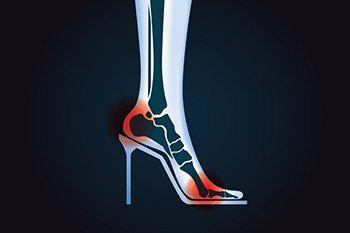
Wearing high heels places excessive pressure on the feet, leading to pain and discomfort. The elevated heel shifts body weight forward, forcing the toes into a cramped position and increasing stress on the ball of the foot. This unnatural alignment can cause issues like bunions, hammertoes, and nerve compression. The lack of proper arch support and cushioning in many high-heeled shoes can lead to muscle strain and fatigue. Prolonged use may also contribute to Achilles tendon tightness and imbalance in posture, increasing the risk of ankle sprains. Walking in high heels alters gait mechanics, placing stress on the knees and lower back. If you have developed foot pain from wearing high heels, it is suggested that you consult a podiatrist who can offer effective relief tips, and guide you on more appropriate shoes to wear.
High heels have a history of causing foot and ankle problems. If you have any concerns about your feet or ankles, contact Dr. Kenneth Donovan from Advanced Care Foot and Ankle. Our doctor can provide the care you need to keep you pain-free and on your feet.
Effects of High Heels on the Feet
High heels are popular shoes among women because of their many styles and societal appeal. Despite this, high heels can still cause many health problems if worn too frequently.
Which Parts of My Body Will Be Affected by High Heels?
- Ankle Joints
- Achilles Tendon – May shorten and stiffen with prolonged wear
- Balls of the Feet
- Knees – Heels cause the knees to bend constantly, creating stress on them
- Back – They decrease the spine’s ability to absorb shock, which may lead to back pain. The vertebrae of the lower back may compress.
What Kinds of Foot Problems Can Develop from Wearing High Heels?
- Corns
- Calluses
- Hammertoe
- Bunions
- Morton’s Neuroma
- Plantar Fasciitis
How Can I Still Wear High Heels and Maintain Foot Health?
If you want to wear high heeled shoes, make sure that you are not wearing them every day, as this will help prevent long term physical problems. Try wearing thicker heels as opposed to stilettos to distribute weight more evenly across the feet. Always make sure you are wearing the proper shoes for the right occasion, such as sneakers for exercising. If you walk to work, try carrying your heels with you and changing into them once you arrive at work. Adding inserts to your heels can help cushion your feet and absorb shock. Full foot inserts or metatarsal pads are available.
If you have any questions please feel free to contact one of our offices located in Warren, Livingston, and Toms River, NJ . We offer the newest diagnostic and treatment technologies for all your foot and ankle needs.
Plantar Warts Can Be Treated!
Unconventional Ways to Keep Your Feet Strong and Flexible

Feet do a lot of work, but they rarely get the focused movement they need to stay resilient. Instead of traditional exercises, try creative approaches that challenge strength, coordination, and flexibility in everyday activities. One simple exercise is the towel scrunch challenge where you place a towel on the floor and use only your toes to scrunch it up. This builds foot muscles, improves dexterity, and enhances grip strength for better balance. Another great activity is the heel-to-toe obstacle walk. This involves setting up small objects like books or pillows and carefully stepping over them, rolling from heel to toe to encourage stability, control, and coordination in a way that mimics real-life movement. For sensory stimulation, try barefoot texture exploration by walking on different surfaces like grass, sand, or a textured mat to awaken nerve endings and improve foot awareness. If you have persistent discomfort or weakness in your feet, it is suggested that you see a podiatrist.
Stretching the feet is a great way to prevent injuries. If you have any concerns with your feet consult with Dr. Kenneth Donovan from Advanced Care Foot and Ankle. Our doctor will assess your condition and provide you with quality foot and ankle treatment.
Stretching the Feet
Stretching the muscles in the foot is an important part in any physical activity. Feet that are tight can lead to less flexibility and make you more prone to injury. One of the most common forms of foot pain, plantar fasciitis, can be stretched out to help ease the pain. Stretching can not only ease pain from plantar fasciitis but also prevent it as well. However, it is important to see a podiatrist first if stretching is right for you. Podiatrists can also recommend other ways to stretch your feet. Once you know whether stretching is right for you, here are some excellent stretches you can do.
- Using a foam roller or any cylindrical object (a water bottle or soda can will do), roll the object under your foot back and forth. You should also exert pressure on the object. Be sure to do this to both feet for a minute. Do this exercise three times each.
- Similar to the previous one, take a ball, such as a tennis ball, and roll it under your foot while seated and exert pressure on it.
- Grab a resistance band or towel and take a seat. If you are using a towel, fold it length wise. Next put either one between the ball of your foot and heel and pull with both hands on each side towards you. Hold this for 15 seconds and then switch feet. Do this three times for each foot.
- Finally hold your big toe while crossing one leg over the other. Pull the toe towards you and hold for 15 seconds. Once again do this three times per foot.
It is best to go easy when first stretching your foot and work your way up. If your foot starts hurting, stop exercising and ice and rest the foot. It is advised to then see a podiatrist for help.
If you have any questions, please feel free to contact one of our offices located in Warren, Livingston, and Toms River, NJ . We offer the newest diagnostic and treatment technologies for all your foot care needs.
Reasons for Heel Pain After Running
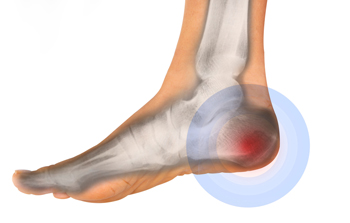
Heel pain after running is a common complaint among runners and can stem from various foot conditions. Plantar fasciitis, one of the leading causes of heel pain after running, occurs when the thick tissue on the bottom of the foot becomes strained from repetitive impact. Other potential sources of heel pain are Achilles tendinitis, stress fractures, or heel spurs, which may develop due to excessive strain on the heel. Running on hard surfaces, wearing improper footwear, or sudden increases in training intensity can contribute to the problem. Symptoms include sharp pain in the heel, stiffness in the ankle, and tenderness along the arch or Achilles tendon. If left untreated, the heel pain can worsen, making daily activities like standing and walking more difficult. A podiatrist can evaluate the underlying cause of heel pain, recommend treatment to relieve discomfort, and offer guidance on proper footwear and running techniques to reduce strain on the feet. If you experience heel pain after running, it is suggested that you schedule an appointment with a podiatrist for an exam and appropriate treatment.
Many people suffer from bouts of heel pain. For more information, contact Dr. Kenneth Donovan of Advanced Care Foot and Ankle. Our doctor can provide the care you need to keep you pain-free and on your feet.
Causes of Heel Pain
Heel pain is often associated with plantar fasciitis. The plantar fascia is a band of tissues that extends along the bottom of the foot. A rip or tear in this ligament can cause inflammation of the tissue.
Achilles tendonitis is another cause of heel pain. Inflammation of the Achilles tendon will cause pain from fractures and muscle tearing. Lack of flexibility is also another symptom.
Heel spurs are another cause of pain. When the tissues of the plantar fascia undergo a great deal of stress, it can lead to ligament separation from the heel bone, causing heel spurs.
Why Might Heel Pain Occur?
- Wearing ill-fitting shoes
- Wearing non-supportive shoes
- Weight change
- Excessive running
Treatments
Heel pain should be treated as soon as possible for immediate results. Keeping your feet in a stress-free environment will help. If you suffer from Achilles tendonitis or plantar fasciitis, applying ice will reduce the swelling. Stretching before an exercise like running will help the muscles. Using all these tips will help make heel pain a condition of the past.
If you have any questions please contact one of our offices located in Warren, Livingston, and Toms River, NJ . We offer the newest diagnostic and treatment technologies for all your foot and ankle needs.
Causes and Symptoms of Toe Cysts
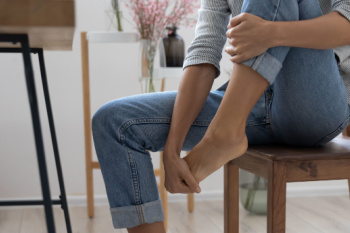
A toe cyst, medically referred to as a myxoid cyst, is a fluid-filled sac that forms near the joints of the toes. They are typically located at the end of the toe or on the nail fold and may appear as small, soft, translucent bumps. These cysts are filled with a jelly-like substance that gives them a characteristic appearance. The primary symptom of a toe cyst is swelling and discomfort in the affected area. In some cases, it can lead to pain, especially when pressure is applied to the cyst. As the cyst grows, it can cause nail deformities and interfere with walking. The exact cause of a myxoid cyst is not entirely understood, but it is often associated with joint degeneration, trauma, or wear and tear on the toe. While the condition is typically benign, a myxoid cyst rarely shrinks on its own. For that reason, it is suggested that you consult a podiatrist who can monitor this condition and provide the necessary treatment.
Toe pain can disrupt your daily activities. If you have any concerns, contact Dr. Kenneth Donovan of Advanced Care Foot and Ankle. Our doctor can provide the care you need to keep you pain-free and on your feet.
What Causes Toe Pain?
Most severe toe pain is caused due to a sports injury, trauma from dropping something heavy on the toe, or bumping into something rigid. Other problems can develop over time for various reasons.
Toe pain can be caused by one or more ailments. The most common include:
- Trauma
- Sports injury
- Wearing shoes that are too tight
- Arthritis
- Gout
- Corns and calluses
- Hammertoe
- Bunions
- Blisters
- Ingrown toenails
- Sprains
- Fractures (broken bones)
- Dislocations
When to See a Podiatrist
- Severe pain
- Persistent pain that lasts more than a week
- Signs of infection
- Continued swelling
- Pain that prevents walking
Diagnosis
In many cases the cause of toe pain is obvious, but in others, a podiatrist may want to use more advanced methods to determine the problem. These can range from simple visual inspections and sensation tests to X-rays and MRI scans. Prior medical history, family medical history, and any recent physical traumatic events will all be taken into consideration for a proper diagnosis.
Treatment
Treatments for toe pain and injuries vary and may include shoe inserts, padding, taping, medicines, injections, and in some cases, surgery. If you believe that you have broken a toe, please see a podiatrist as soon as possible.
If you have any questions please feel free to contact one of our offices located in Warren, Livingston, and Toms River, NJ . We offer the newest diagnostic tools and technology to treat your foot and ankle needs.
